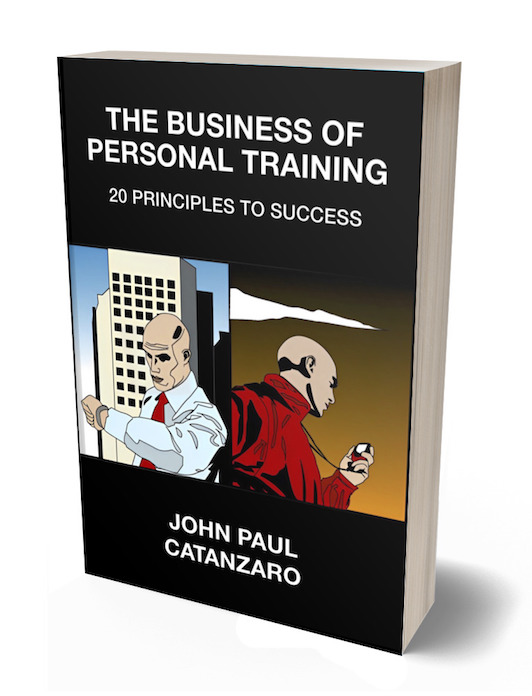Clients hire you for a specific purpose, and your success ultimately depends on the effectiveness of your training programs. The first thing to consider when designing a program is the training goal—this single factor trumps all others. For instance, an individual with recurring shoulder pain and extremely poor posture may approach you with the goal of entering a powerlifting contest in the next few months. Your job is to train them to bench press as much weight as possible, even though it may further compromise shoulder integrity and deteriorate posture!
Be clear and concise with the objective. Establish as many details as possible and set SMART goals—specific, measurable, attainable, relevant, and time-bound.
Make sure your client understands the difference between reality and fiction. Every guy who’s picked up a weight wants to look like Arnold Schwarzenegger, but Arnold was only in peak condition for a day or two around a bodybuilding contest—that’s when most of the great photos were taken. The cast of 300, both guys and gals, trained for three months straight, four hours a day (Gerard Butler actually trained six hours a day for his role), and they were in top shape for only a week during filming. It’s rumored that Demi Moore spent over $120,000 on plastic surgery for Striptease. These are all great actors playing fictional characters, but the reality is that they were in peak shape for only a short period of time—and it took countless hours in the gym and a lot of money to get there.
Rule #1: Establish SMART and realistic goals
You can’t control the outcome, so focus on the process and let the results take care of themselves. Many people point at magazine ads and say, “I want to look like this!” But aside from genetics, disciplined nutrition and lifestyle habits, extreme dieting, frequent training, possible drug use, airbrushing, and years of hard work, you have to consider what those models are actually capable of.
For example, it’s not uncommon for a top female fitness model to perform chin-ups and dips, and squat her body weight (or more) for high reps. So if your client wants to look like that model, their first goal should be to achieve at least one controlled, unassisted chin-up and dip, and squat half their body weight for high reps. That’s the starting point—they can work up from there. I discuss this concept in The Elite Trainer.
Rule #2: Focus on the process, not the outcome
Training and exercise are often used interchangeably, but they’re not the same. Both involve physical activity and both are better than lying on the couch, but that’s where the similarities end.
Training involves planned sessions—what many Russian and European lifters call “lessons”—designed to achieve long-term objectives. It’s not just a series of random exercises that raise your heart rate and make you sweat. Training is about progression—getting better with each session. Exercise, on the other hand, is about today. Think of it as maintenance—doing the same thing over and over just for the sake of movement.
Strength coach Mark Rippetoe has been outspoken on the “training versus exercise” debate. He puts it simply:
If a program of physical activity isn’t designed to make you stronger, faster, or better conditioned by producing a specific stress that leads to a desirable adaptation, it’s not training—it’s just exercise.
For many people, exercise is good enough. They just want to burn some calories, get a little conditioning work, and have better abs. That’s fine. But the second you want more—when you decide to work toward a goal—you’ve graduated to training.
Training is the most effective way to get results, even if your goal is weight loss. Following a plan that continually increases strength and endurance while also addressing diet is far superior to doing the same exercises with the same weight, for the same duration, on the same days of the week, for months on end.
Rule #3: Train your clients for more than just maintenance
Just as you shouldn’t rely on one guru or one certification, don’t marry yourself to one training method—especially if it’s a new industry trend. Fads come and go.
Take kettlebells, for example. They’ve been around since the 1700s but nearly disappeared for a reason—they’re tough on the wrists and elbows. Now they’ve made a comeback, but they offer no real advantage over barbells and dumbbells. Sure, they’re different, but not necessarily better. And soon enough, they may fade away again.
Strength coach William Wayland warns against getting emotionally invested in a training approach:
When you have a hammer, everything looks like a nail. The kettlebell ends up getting used for everything.
Steve Maxwell, a kettlebell proponent and BJJ black belt, puts it bluntly:
This is like using a screwdriver to pound a nail. You can do it, but it’s dumb.
The British military banned kettlebells years ago due to high injury rates. According to Body by Science author Dr. Doug McGuff:
If you are a kettlebell enthusiast, injury is not a matter of if, but when.
Rule #4: Train your clients—don’t injure them!
The Swiss ball is another example. In the mid-’90s, it was mostly used for physiotherapy. When I first mentioned it to other trainers, they had no clue what I was talking about.
At first, it gained traction because it was novel and somewhat challenging. But after mastering the moves, there was little room for progression. In fact, performance often regressed. Charles Poliquin introduced me to the Swiss ball nearly 20 years ago, and he initially used it with Olympic athletes. The result? Fewer medals. When he returned to conventional weight training, the medals piled up again.
Rule #5: Train your clients to progress, not to regress
Use the 80/20 principle: 80% of the time, stick to the basic lifts that have stood the test of time, and 20% can be used for “fluff” or what’s popular today.
Sure, you can use kettlebells for swings and Swiss balls for some core work, but if you truly want results, return to the basics. Don’t fool around. Squats, deadlifts, presses, chin-ups, rows—these are the exercises that work!
Rule #6: Clients come to you for a reason. Train them, don’t entertain them.
How do you break the monotony of training? It’s simple—change the routine every four weeks or so. Once a client adapts to a program, you need to alter the stimulus to keep them progressing.
If they stay on the same program too long, not only will progress stall, but they’ll likely get injured if you try to push through. Plus, they’ll get bored. And when the nervous system is begging for something new, if you don’t change the program, they’ll change trainers!
Note: For more tips, check out The Business of Personal Training: 20 Principles to Success.
References
- Alwyn Cosgrove. The Only Way to Help Your Clients Burn Fat Fast. Ryan Lee’s Bootcamp II, 2006.
- Doug McGuff. Doug McGuff on Lower Back Training. Conditioning Research, 2010.
- John Paul Catanzaro. The Elite Trainer. The Catanzaro Group, 2011.
- Mark Rippetoe. Rippetoe Throws Down. T-Nation, 2013.
- Mark Rippetoe. The Biggest Training Fallacy of All. T-Nation, 2011.
- Mark Rippetoe. The Important Distinction Between Exercising and Training. Huffington Post, 2014.
- William Wayland. Are Kettlebells Worth Your Time? Scramble Stuff, 2012.

The Business of Personal Training: 20 Principles to Success

Beyond Reps: The Trainer’s Hidden Effort
The role of a personal trainer goes far beyond counting reps or demonstrating exercises. Clients often underestimate how much energy

Guiding Personal Trainers to Success: A Comprehensive Resource
In the aftermath of the pandemic, many personal trainers have found themselves struggling to rebuild the business they once had.

Mastering the Craft: 10 Essential Rules Every Personal Trainer Must Follow for Success
Becoming a successful personal trainer requires more than just knowledge of exercises and anatomy—it demands professionalism, communication skills, and a
follow
Error: No feed with the ID 2 found.
Please go to the Instagram Feed settings page to create a feed.
